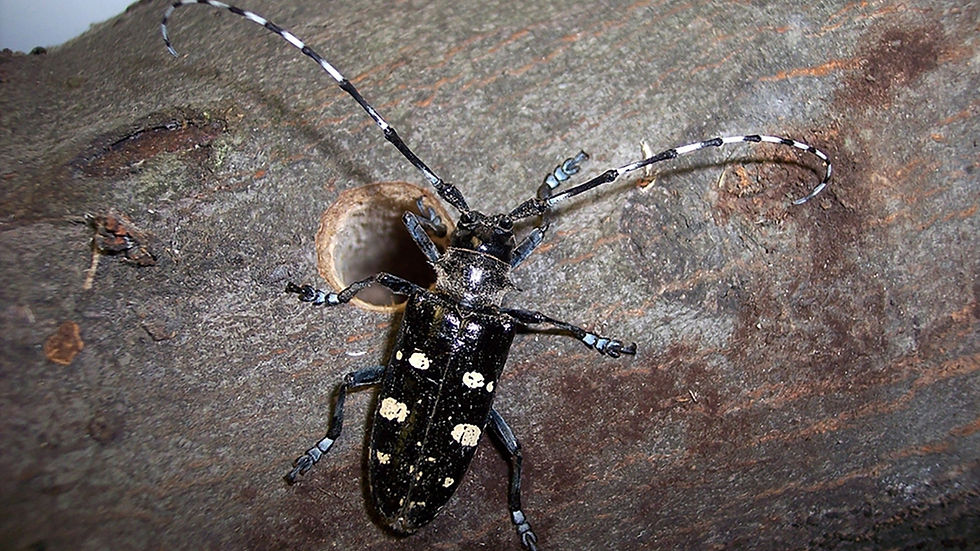Battling the Invaders
- matthew jackson
- 3 days ago
- 3 min read
What You Need to Know About Invasive Insects in Wisconsin
Asian Longhorned Beetle, Spongy Moth & Spotted Lanternfly
At Waterford Bee Company, we’re passionate about protecting pollinators and maintaining healthy ecosystems—but those efforts are increasingly challenged by invasive insect species. Three major threats currently drawing concern across the Midwest and beyond are the Asian Longhorned Beetle, the Spongy Moth (formerly known as the gypsy moth), and the Spotted Lanternfly.
These pests may not directly target honey bees, but they damage native trees, disrupt habitats, and create imbalances that ripple through entire ecosystems—including those that pollinators depend on. Here's what you need to know to spot them and help stop their spread.

Asian Longhorned Beetle (ALB)
Threat:The Asian Longhorned Beetle targets hardwood trees—especially maples, elms, birches, and poplars. Once inside a tree, its larvae bore deep tunnels that cut off the tree’s ability to transport water and nutrients, ultimately killing it.
How to Spot It:
Large, glossy black beetle with white spots and long, banded antennae
Oval exit holes (about the size of a pencil) in the bark
Sawdust-like frass near tree bases or branches
Wilting or dying branches, even on otherwise healthy trees
What You Can Do:
Report any sightings immediately to the Wisconsin DNR or USDA APHIS
Don’t transport firewood across regions—it’s one of the easiest ways this beetle spreads
Inspect trees regularly, especially maples and other favored hardwoods

Spongy Moth
Threat:Spongy Moth caterpillars devour the leaves of over 300 tree and shrub species, including oaks, aspens, and fruit trees. Severe infestations can lead to defoliation, weakening trees and making them vulnerable to disease and other pests.
How to Spot It:
Egg masses: tan, fuzzy, and about the size of a quarter, often found on tree bark, outdoor furniture, or firewood
Caterpillars: dark with long hairs and rows of blue and red dots
Heavy leaf loss in spring and early summer
What You Can Do:
Scrape off and destroy egg masses in fall and winter
Use burlap tree wraps to trap caterpillars in spring
Keep trees healthy through proper watering and mulching to improve resilience
Participate in local eradication or suppression programs

Spotted Lanternfly (SLF)
Threat: Originally from Asia, the Spotted Lanternfly feeds on the sap of trees and crops like grapes, apples, hops, and maples. It excretes a sticky substance called honeydew, which encourages mold growth and attracts other pests. Though not yet established in Wisconsin, it's been found in neighboring states—and the concern is growing.
How to Spot It:
Adults: about 1 inch long, with gray wings and black spots; bright red hindwings
Nymphs: black or red with white spots
Egg masses: grayish and mud-like, laid on trees, vehicles, or outdoor objects
What You Can Do:
Scrape off egg masses and destroy them
Inspect vehicles, firewood, and outdoor gear when traveling from infested areas
Report sightings to your local ag extension or the Wisconsin DNR immediately
Why It Matters to Beekeepers & Nature-Lovers
While these invasive insects don’t directly target honey bees, their presence impacts the broader environment bees depend on—from native trees to wildflower diversity. A weakened ecosystem means fewer food sources, compromised habitats, and added stress on pollinators already facing threats from pesticides, habitat loss, and climate change.
What You Can Do
Stay informed and share your knowledge
Support local conservation and forestry efforts
Choose native plants and trees in your landscaping
Buy local firewood—don’t move it
Encourage neighbors to check for and report infestations
Keep an eye on state alerts and eradication programs
Together, we can be part of the solution. Protecting pollinators doesn’t stop at the hive—it includes the trees, soil, and landscapes around us. At Waterford Bee Company, we believe healthy hives start with a healthy ecosystem, and that means keeping a watchful eye on these invasive pests.
Stay vigilant. Stay informed. And let’s keep Wisconsin buzzing.

.png)



Comments